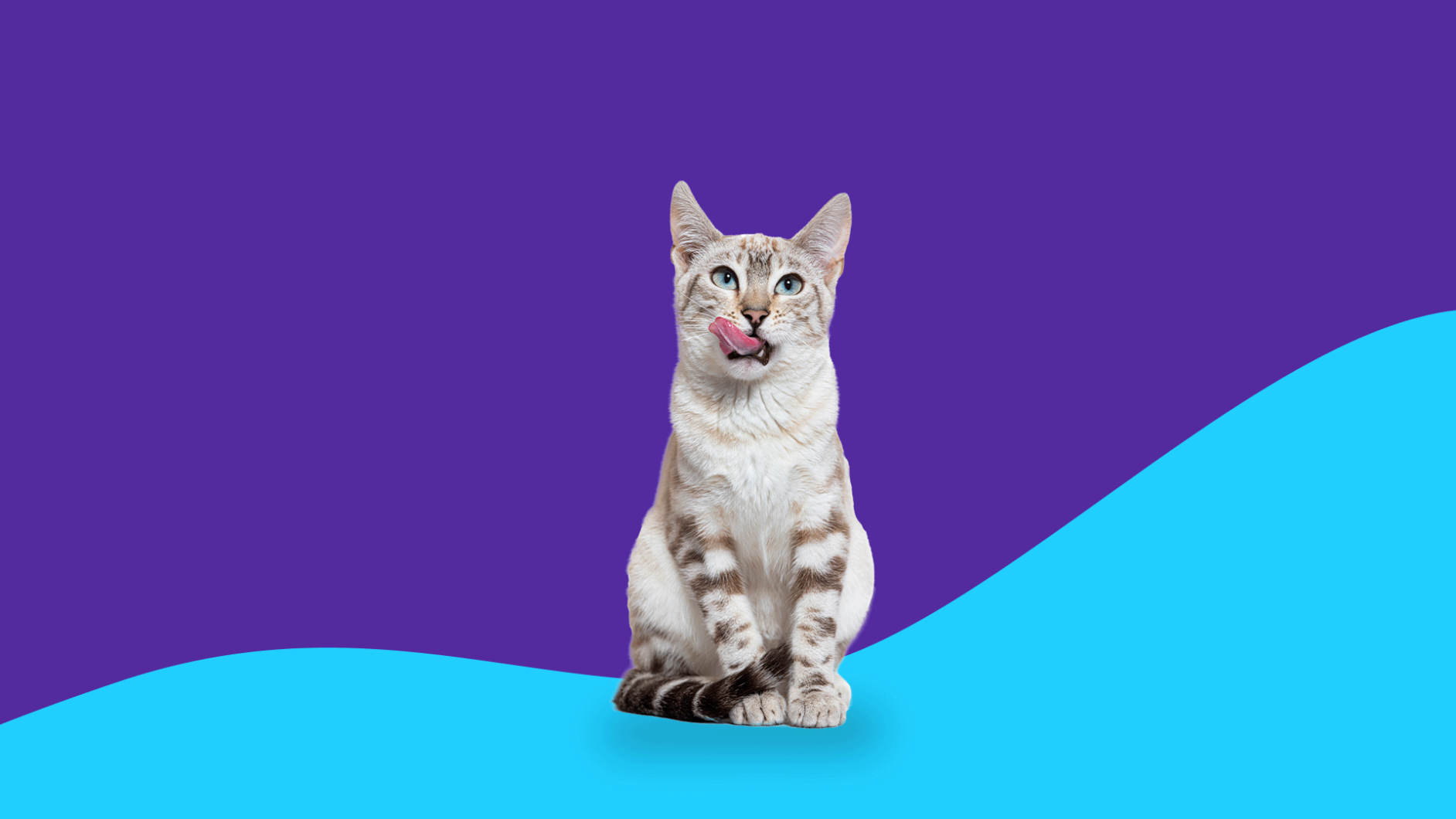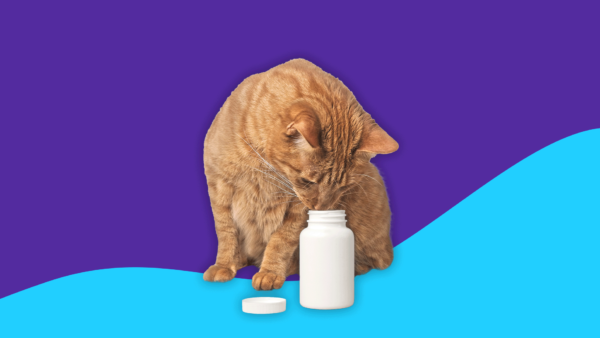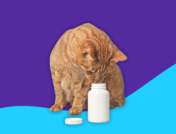Benadryl, or diphenhydramine hydrochloride in its generic form, is an antihistamine commonly prescribed to treat allergy symptoms like a runny nose, sneezing, or itching. Additionally, brand-name Benadryl is an antiemetic, which means it can help reduce nausea and vomiting, and it can be used as a sleep aid or anti-anxiety medication (thanks to its side effect of drowsiness).
You may be surprised to learn that Benadryl isn’t just for humans in the household. Read on to see what veterinarians recommend about treating your cat’s allergies.
Can you give cats Benadryl?
Found over the counter, Benadryl can be given to cats for allergies or other health issues. There are many forms of Benadryl, including liquid, topical, and tablet, and some will work better than others to meet your pet’s needs. Much like in humans, cats can take Benadryl to treat allergies, nausea, sleep, and anxiety.
Allergies
“Benadryl is most often used for cats to help with sudden allergic reactions, such as a bee sting,” says Chyrle Bonk, DVM, an Idaho-based veterinarian and cat expert at Cat World. “It can also be used long term for other types of allergies, but it has varying success.”
Cat allergy symptoms are similar to those of humans with allergies: a runny nose, sneezing, itching, and/or upper respiratory issues. Cats can also have itchy, irritated skin due to allergies. Depending on what they are allergic to, cats may have these allergy symptoms seasonally, like during spring, or year-round.
Benadryl works well as an allergy medication because it “can help decrease the mucus in your cat’s nose and help with upper respiratory issues due to grass and pollen,” says Sara Ochoa, DVM, a veterinarian in Louisiana. But not all allergy medications for humans are recommended for cats—and you shouldn’t give anything without first checking with your veterinarian.
Anti-nausea
Benadryl also has antiemetic properties, meaning it can prevent vomiting. This can be helpful if you have a pet that gets motion sick while traveling in the car or plane. Dramamine (dimenhydrinate) is a common over-the-counter motion sickness medication that is similar to Benadryl and is also prescribed to cats for motion sickness.
RELATED: Do cats get car sick?
Sleep or anxiety
Because Benadryl can cause drowsiness, many pet owners use the mild sedative to their advantage. A vet-approved recommended dose of the med, can work as a sleep aid before long travel or a calming Rx if your pet is very anxious and needs to rest. Some pets even take Benadryl to sedate them slightly before visiting the veterinarian.
“While they do not get as sleepy as humans,” Dr. Ochoa says, “cats will tend to sleep a little more on days when they have taken Benadryl.”
Benadryl dosage for cats
Always check with your veterinarian before giving your cat Benadryl. They will determine if it’s right for your cat and help you calculate the proper dosage of Benadryl.
“The amount of Benadryl that you give your cat will be prescribed by your veterinarian,” Dr. Bonk says. “The dose will depend on their weight, what you’re trying to treat, and any health conditions they have.”
That being said, Dr. Ochoa says that a typical dosage is 1 mg per pound, every eight to 12 hours. “So, a 12-pound cat would need to take about half of an adult 25 mg tablet,” she says.
The correct dosage will also depend on what format you use. Dr. Bonk says giving liquid Benadryl is often easier than pill form and you can get a more accurate dosage. Oral Benadryl will begin working half an hour to an hour after ingestion.
“Tablets can take a few hours to reach peak levels in your cat’s body,” Dr. Ochoa says, so plan accordingly if you’re using Benadryl before a plane or car ride to optimize the effects.
Benadryl also can be given as an injection, which is a good way to get it into your cat’s system quickly.
Benadryl for cats’ side effects
Besides the sometimes beneficial side effect of sleepiness, there are several other possible side effects of Benadryl. These include:
- Lethargy
- Dry mouth
- Lack of urination or urinary retention
- Vomiting
- Diarrhea
- Lack of appetite
- Excitement
- Foaming at the mouth
Monitor your cat for side effects and speak to your vet about alternate options if needed.
Do not be too concerned if your cat foams at the mouth after taking Benadryl. “Liquid Benadryl may cause foaming at the mouth or drooling because it is often flavored with a sweetener to taste like bubble gum or cherry. Your cat may not like these tastes,” Dr. Bonk says. “Similarly, Benadryl tablets may have a bitter taste that could cause drooling or foaming at the mouth.”
Benadryl will last in your cat’s system for six to 12 hours, at which point both the intended effects and the side effects should go away. At your vet’s discretion, you may need to re-dose your pet every eight to 24 hours.
Is Benadryl safe for cats?
When used under a veterinarian’s supervision, Benadryl is considered generally safe for cats. However, there are several contraindications or drug interactions pet owners should be aware of.
Before prescribing Benadryl, your vet will perform a checkup and ensure they do not have any health conditions that would indicate they shouldn’t be in on the medication, such as:
- Glaucoma
- Chronic Obstructive Pulonary Disease (COPD)
- Urinary obstruction
- Hyperthyroidism
- Cardiovascular disease
- High blood pressure
Additionally, your feline friend can’t take Benadryl if they are on sedative medications, pain medications, or antidepressants.
“Be sure to tell your vet about any medications or even supplements that your cat is taking,” Dr. Bonk says. Mixing medications with Benadryl can lead to serious side effects or even death.
Overdosing on Benadryl can have serious ramifications for your pet, so it’s important that you don’t give your pet more than your vet recommends. Besides the worsening of side effects, too much Benadryl can lead to coma or even death.
Natural alternatives to Benadryl for cats
If you are unable to use Benadryl on your cat, there are natural alternatives you can use.
If you are using Benadryl for skin allergy treatment, Dr. Bonk recommends natural anti-inflammatories such as vitamin E and fish oil as they help restore the natural skin barrier. Cats can get vitamin E from food, such as fish, or as a supplement.
Fish oil is usually given to cats in the form of a capsule or the liquid from the capsule. Oils can have some unwanted side effects, including diarrhea and vomiting—so be sure to tell your cat’s vet if you notice any adverse side effects.
Bathing with shampoos that contain oatmeal or fatty acids can also help soothe the symptoms of allergic skin disease. Not all cats are accepting of baths, but if your cat tolerates bathing, this method can be very effective for itchy skin.
If your pet has itchy skin, Dr. Ochoa recommends CBD. “Cannabidiol (CBD) products can also help decrease the inflammation and irritation of your cat’s skin,” she says. CBD is often sold as a supplement or chew formulated for cats.
With all natural treatments, always discuss your cat’s health history with your cat’s veterinarian, including medications, health conditions, or supplements, before trying a new regimen.
Getting your feline friend the proper medication or supplement will help them stay comfortable during allergy season, a big travel day, a vet visit, or when they have an upset stomach.











